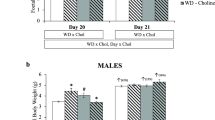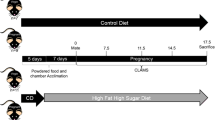Abstract
Maternal food restriction (FR) during pregnancy results in decreased body weight with increased plasma leptin. To address this paradox, we investigated the effects ofFR during pregnancy on growth and leptin levels in maternal, placental, and fetal sites. From embryonic day E10, control pregnant rats received ad libitum (AdLib) food, whereas study rats were 50% FR. At gestational ages, E16 and E20, the alterations in maternal body composition, retroperitoneal versus subcutaneous adipose leptin expression, and plasma leptin levels were studied. Furthermore, these changes were related to non-pregnant (NP) status and placental/fetal growth and leptin levels. As compared to NP, both FR and AdLib dams showed a progressive increase in body and lean body mass. However, total body fat was reduced in FR dams but remained unchanged in AdLib dams. Furthermore, plasma leptin levels in FR dams were markedly increased at E20 unlike AdLib dams, which showed moderate increments at E16 and E20. Additionally, FR dams showed significantly decreased leptin expression in subcutaneous and notably unaltered levels in retroperitoneal adipose tissue, suggesting an alternate source of elevated maternal plasma leptin. More importantly, the FR dams had reduced placental weights with paradoxical increased leptin expression at both gestations. Thus, increased plasma leptin levels at E20 in maternal FR pregnancies may be explained, in part, by upregulation of placental leptin. Despite maternal and placental hyperleptinemia during FR pregnancies, the growth-restricted FR fetus had reduced leptin levels. These findings have important implications for pregnancy outcome and fetal growth.
Similar content being viewed by others
References
Hales CN, Barker DJ. The thrifty phenotype hypothesis. Br Med Bull. 2001;60:5–20.
Ross MG, Desai M. Gestational programming: population survival effects of drought and famine during pregnancy. Am J Physiol Regul Integr Comp Physiol. 2005;288(1):R25-R33.
Desai M, Hales CN. Role of fetal and infant growth in programming metabolism in later life. Biol Rev Camb Philos Soc. 1997;72(2):329–348.
Bergmann RL, Bergmann KE, Dudenhausen JW. Undernu-trition and growth restriction in pregnancy. Nestle Nutr Workshop Ser Pediatr Program. 2008;61:103–121.
Godfrey KM. The role of the placenta in fetal programming— a review. Placenta. 2002;23(suppl A):S20-S27.
Jansson T, Powell TL. Role of the placenta in fetal programming: underlying mechanisms and potential interventional approaches. Clin Sci (Lond). 2007;113(1):1–13.
Coll AP, Farooqi IS, O’Rahilly S. The hormonal control of food intake. Cell. 2007;129(2):251–262.
Hoggard N, Haggarty P, Thomas L, Lea RG. Leptin expression in placental and fetal tissues: does leptin have a functional role? Biochem Soc Trans. 2001;29(pt 2):57–63.
Ashworth CJ, Hoggard N, Thomas L, Mercer JG, Wallace JM, Lea RG. Placental leptin. Rev Reprod. 2000;5(1):18–24.
Tomimatsu T, Yamaguchi M, Murakami T, et al. Increase of mouse leptin production by adipose tissue after midpregnancy: gestational profile of serum leptin concentration. Biochem Biophys Res Commun. 1997;240(1):213–215.
Chien EK, Hara M, Rouard M, et al. Increase in serum leptin and uterine leptin receptor messenger RNA levels during pregnancy in rats. Biochem Biophys Res Commun. 1997;237(2): 476–480.
Sagawa N, Yura S, Itoh H, et al. Possible role of placental lep-tin in pregnancy: a review. Endocrine. 2002;19(1):65–71.
Masuzaki H, Ogawa Y, Sagawa N, et al. Nonadipose tissue production of leptin: leptin as a novel placenta-derived hormone in humans. Nat Med. 1997;3(9):1029–1033.
Hoggard N, Hunter L, Duncan JS, Williams LM, Trayhurn P, Mercer JG. Leptin and leptin receptor mRNA and protein expression in the murine fetus and placenta. Proc Natl Acad Sci U S A. 1997;94(20):11073–11078.
Lea RG, Howe D, Hannah LT, Bonneau O, Hunter L, Hoggard N. Placental leptin in normal, diabetic and fetal growth-retarded pregnancies. Mol Hum Reprod. 2000;6(8): 763–769.
Challier J, Galtier M, Bintein T, Cortez A, Lepercq J, Hau-guel-de MS. Placental leptin receptor isoforms in normal and pathological pregnancies. Placenta. 2003;24(1):92–99.
Sugden MC, Langdown ML, Munns MJ, Holness MJ. Maternal glucocorticoid treatment modulates placental leptin and leptin receptor expression and materno-fetal leptin physiology during late pregnancy, and elicits hypertension associated with hyperleptinaemia in the early-growth-retarded adult offspring. Eur J Endocrinol. 2001;145(4):529–539.
Lepercq J, Guerre-Millo M, Andre J, Cauzac M, Hauguel-de MS. Leptin: a potential marker of placental insufficiency. Gynecol Obstet Invest. 2003;55(3):151–155.
Jelks A, Gayle DA, Casillas E, Ross MG, Desai M. Paradoxically increased placental leptin mRNA expression in response to maternal food restriction. Early Hum Dev. 2006;82:554.
Sagawa N, Yura S, Itoh H, et al. Role of leptin in preg-nancy—a review. Placenta. 2002;23(suppl A):S80-S86.
Pujol E, Proenza A, Llado I, Roca P. Pregnancy effects on rat adipose tissue lipolytic capacity are dependent on anatomical location. Cell Physiol Biochem. 2005;16(4–6):229–236.
Pujol E, Proenza AM, Roca P, Llado I. Changes in mammary fat pad composition and lipolytic capacity throughout pregnancy. Cell Tissue Res. 2006;323(3):505–511.
Margetic S, Gazzola C, Pegg GG, Hill RA. Leptin: a review of its peripheral actions and interactions. Int J Obes Relat Metab Disord. 2002;26(11):1407–1433.
Seeber RM, Smith JT, Waddell BJ. Plasma leptin-binding activity and hypothalamic leptin receptor expression during pregnancy and lactation in the rat. Biol Reprod. 2002;66(6): 1762–1767.
Yang G, Ge H, Boucher A, Yu X, Li C. Modulation of direct leptin signaling by soluble leptin receptor. Mol Endocrinol. 2004;18(6):1354–1362.
Gavrilova O, Barr V, Marcus-Samuels B, Reitman M. Hyper-leptinemia of pregnancy associated with the appearance of a circulating form of the leptin receptor. J Biol Chem. 1997;272(48):30546–30551.
Henson MC, Castracane VD. Leptin in pregnancy: an update. Biol Reprod. 2006;74(2):218–229.
Jelks A, Gayle DA, Casillas E, Ross MG, Desai M. Fetal protection from excess glucocorticoid exposure: downregulation of placental 11beta-hydroxysteroid dehydrogenase. Early Hum Dev. 2006;82:547.
Kyriakakou M, Malamitsi-Puchner A, Militsi H, et al. Leptin and adiponectin concentrations in intrauterine growth restricted and appropriate for gestational age fetuses, neonates, and their mothers. Eur J Endocrinol. 2008;158(3):343–348.
Moore LE, Wallace KL, Alexander BT, May WL, Thigpen BD, Bennett WA. Reduced placental perfusion causes an increase in maternal serum leptin. Placenta. 2003;24(8–9):877–881.
Grosfeld A, Andre J, Hauguel-de MS, Berra E, Pouyssegur J, Guerre-Millo M. Hypoxia-inducible factor 1 transactivates the human leptin gene promoter. J Biol Chem. 2002;277(45): 42953–42957.
Raso GM, Bianco G, Iacono A, et al. Maternal adaptations to pregnancy in spontaneously hypertensive rats: leptin and ghre-lin evaluation. J Endocrinol. 2007;194(3):611–619.
Martinez-Cordero C, Amador-Licona N, Guizar-Mendoza JM, Hernandez-Mendez J, Ruelas-Orozco G. Body fat at birth and cord blood levels of insulin, adiponectin, leptin, and insulin-like growth factor-I in small-for-gestational-age infants. Arch Med Res. 2006;37(4):490–494.
Tsai PJ, Yu CH, Hsu SP, et al. Cord plasma concentrations of adiponectin and leptin in healthy term neonates: positive correlation with birthweight and neonatal adiposity. Clin Endocrinol (Oxf). 2004;61(1):88–93.
Desai M, Gayle D, Babu J, Ross MG. Programmed obesity in intrauterine growth-restricted newborns: modulation by newborn nutrition. Am J Physiol Regul Integr Comp Physiol. 2005;288(1):R91-R96.
Smith JT, Waddell BJ. Leptin distribution and metabolism in the pregnant rat: transplacental leptin passage increases in late gestation but is reduced by excess glucocorticoids. Endocrinology. 2003;144(7):3024–3030.
Desai M, Gayle D, Han G, Ross MG. Programmed hyper-phagia due to reduced anorexigenic mechanisms in intrau-terine growth-restricted offspring. Reprod Sci. 2007;14(4): 329–337.
Stocker C, O’Dowd J, Morton NM, et al. Modulation of susceptibility to weight gain and insulin resistance in low birth-weight rats by treatment of their mothers with leptin during pregnancy and lactation. Int J Obes Relat Metab Disord. 2004;28(1):129–136.
Author information
Authors and Affiliations
Corresponding author
Rights and permissions
About this article
Cite this article
Jelks, A., Belkacemi, L., Han, G. et al. Paradoxical Increase in Maternal Plasma Leptin Levels in Food-Restricted Gestation: Contribution by Placental and Adipose Tissue. Reprod. Sci. 16, 665–675 (2009). https://doi.org/10.1177/1933719109334257
Published:
Issue Date:
DOI: https://doi.org/10.1177/1933719109334257




